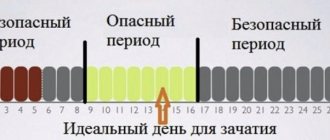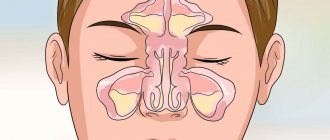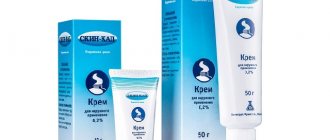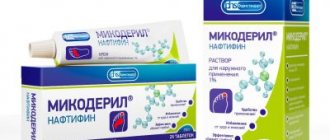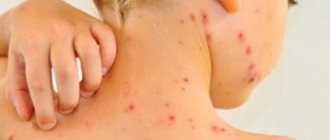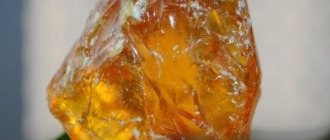What is eczema
Eczema on the hands is an acute or chronic reaction of the body, which is accompanied by the appearance of a skin rash in the form of small blisters on various parts of the body. The rashes from the stage of redness and nodules turn into weeping erosions with the appearance of crusts. Throughout the course of the disease, the person experiences severe burning and itching. When scratching the rash, the risk of secondary purulent infection increases, which complicates the treatment process.
The disease is not contagious and is prone to frequent relapses. Occurs in 30-40% of patients who consult a dermatologist. Treatment of eczema is a rather lengthy process that requires an integrated approach. The choice of therapy depends on the cause, form and stage of the disease.
Self-medication, as well as uncontrolled use of any medications, will only worsen the course of the disease, leading to frequent exacerbations and complications.
Eczema: causes
The main reason is immunity disorders and factors that have a depressing and destructive effect on the protective function of the skin. As a result of disruption of the immune system, the body begins to react “inappropriately” to various external stimuli. Accordingly, the causes of eczema on the hands, for example, are detergents (even soap) or cosmetics (perfumes, creams, etc.).
Also “provoking” factors include:
- hereditary predisposition;
- allergic reactions to certain external influences;
- psychosomatic reactions;
- disturbances in the functioning of the endocrine and nervous systems;
- improper functioning of the digestive system;
- external factors, etc.
Only an experienced specialist should determine the causes of eczema on the palms or hands, on the head behind the ears or on the face, in order to then prescribe an effective course of therapeutic and restorative therapy. At the first sign, it is better not to delay visiting a doctor.
Eczema: treatment (on the arms, legs, behind the ears, etc.)
The difficulty of treatment lies not only in the fact that the disease can be chronic, but also in the fact that it affects even the deep layers of the skin. Fast and effective treatment (with the prevention of relapses) is possible only with timely consultation with a doctor. a dermatovenerologist knows how and how to treat eczema on the arms, legs and other parts of the body.
. Self-medication can lead to increased skin lesions and serious complications.
Initial appointment
As a rule, at the initial appointment, the doctor immediately diagnoses eczema by simply examining the patient. During the examination, the locations of eczema lesions are also recorded (on the palms, face, neck, head, behind the ear, etc.), which makes it possible to determine the cause. Examination, examination of tests and complaints, assignment of studies for each specific clinical case are individual.
If eczema is mild, then at the first consultation the doctor will prescribe treatment, its timing and subsequent visits for monitoring. If the disease is more complex, the doctor may prescribe additional tests and examinations.
Diagnostics
General parameters for diagnosing eczema of different types (plaque, atomic, infectious, etc.):
- detailed clinical and laboratory studies to identify pathologies of internal organs;
- analyzes and studies of the functioning of the endocrine and cardiovascular systems;
- analysis for helminthic infestations;
- mycological studies.
When you know why eczema appears, it becomes clear how and with what to treat it. When prescribing a course, the doctor also takes into account the medical history (if this is not a primary infection) and the individual characteristics of the patient in order to cure eczema as quickly as possible.
Repeated appointment
This is a visit to the doctor after undergoing all examinations and tests, as well as the selection of a treatment regimen based on the results of the examinations.
A repeat appointment is also scheduled after completing the course, so that the doctor can make sure that the chosen regimen is effective. If no positive dynamics are observed, then other medications are selected and the course of treatment is adjusted. Additional examinations are possible.
Treatment of weeping or dry, microbial, allergic and varicose, plaque or coin-shaped eczema: general parameters
One of the basic rules during treatment and during periods of exacerbation is to minimize the patient’s contact with water.
As an external treatment, the doctor can prescribe various lotions and compresses to the affected areas and treat the blisters after opening with special ointments and agents. Also, for eczema, a hypoallergenic diet is necessarily indicated.
Control reception
At the initial appointment, the doctor determines the time of the follow-up visit in order to assess the patient’s health status and, if necessary, develop a plan for restorative therapy and rehabilitation after treatment.
As a rule, all measures are aimed at restoring and strengthening the immune system. The doctor already knows why eczema appears in each individual case, where the blisters appear (on the hands or face), in what form (dyshidrotic, microbial, etc.), how and with what to treat and how to recover after treatment.
Treatment results
The disease can be cured, but the timing is always strictly individual. All details are discussed at the doctor’s appointment. Also, if necessary, treatment for other existing diseases that are provoking factors for eczema is prescribed in parallel.
Prevention
To prevent eczema, diet and proper skin care are prescribed, as well as various measures to strengthen the immune system (for example, hardening) and to minimize the causes of relapses.
If possible, it is necessary to exclude any contact with allergens that cause illness, both at home and at work. It is recommended to wear clothes made from natural materials. If a relapse of eczema does occur and an exacerbation begins, then you need to consult a doctor and limit contact with water, soap and other household products.
The medical clinic provides comprehensive diagnosis and treatment of skin diseases, including eczema (wet, dry, microbial, chronic, on the lower leg or behind the ear) using various means and methods. You can make an appointment with a doctor by calling the phone number listed at the top right, or through the website using a special form.
Reasons for development
The etiology of eczema has not been fully studied, but it is known that the cause of development is often heredity, the influence of endogenous and exogenous factors, as well as psychovegetative and immunological disorders. The following factors may be a trigger for the manifestation of symptoms:
- decreased immunity;
- allergic reaction;
- diseases of the endocrine system;
- stress, depression;
- diseases of the digestive system;
- exposure to high or low temperatures.
Under the influence of provoking factors, eczema often recurs, which leads to exacerbations and the appearance of new foci of rash.
Causes of the disease
Until now, doctors cannot unequivocally answer the question about the causes of the development of eczema in adults and children. Most experts agree that the disease develops as a result of the complex influence of endogenous factors (for example, genetic predisposition) and exogenous factors (occupational, etc.). Simply put, external factors most often include various allergens that affect the body constantly or for a long time. To internal, endogenous – genetic predisposition. It has been proven that if there is a person with eczema in the family, the risk of the disease in relatives increases significantly. If one of the parents (mainly the mother) is ill, the risk of developing eczema in a child is approximately 40%; if both parents are ill, it is almost 60%
The most common factors that provoke eczema:
- chronic allergies;
- disturbances in the functioning of the endocrine system;
- psycho-emotional triggers.
They also additionally identify factors that can weaken the body’s immunity and thereby provoke the development of eczema. This:
- chronic inflammatory processes;
- secondary immunodeficiencies;
- diseases of the digestive system;
- foci of chronic infection in the body.
Among the possible causes of eczema are psychosomatics: constant stress, various disorders of the autonomic system, anxiety and depression. Patients often exhibit functional changes in the activity of the central nervous system, a predominance of the activity of unconditioned reflexes over the activity of conditioned ones, as well as an imbalance between the activity of the sympathetic and parasympathetic parts of the autonomic nervous system.
Stages of eczema
The term “eczema” refers to the development of an acute allergic reaction to the skin. The disease has several stages and forms, which are important to recognize when making a diagnosis and selecting therapy. According to the nature of the course, eczema can be:
- Acute – symptoms develop rapidly. Small red blisters appear on the skin, inside the exudate. The skin becomes inflamed, swelling, itching, burning, and peeling appear. After the exudate dries, crusts form, followed by epithelization.
- Subacute - rashes appear as in the acute form with itching and inflammation, but without accumulation of exudate.
- Chronic – accompanied by a period of remission and exacerbation. In chronic eczema, new weeping foci of rashes are adjacent to dry crusts. There is much less exudate, but more dry crusts that itch and peel.
During the development of eczema, the disease goes through 4 stages of development:
- Erythematous - multiple red-pink spots appear on the skin.
- Papular - spots transform into nodules (papules), the skin swells.
- Vesicular - bubbles with exudate appear inside.
- Weeping - papules open, erosions (wounds) appear from which fluid is released.
- Peeling - erosions after the release of exudate become covered with a dry crust.
Several hours or days pass from the moment the rash appears until erosion becomes wet. When scratching the rash, the skin does not heal well, and there is a high risk of secondary infection.
Stages of the disease
If we talk about the features of the course of the disease, then there are usually three stages of its development:
- Spicy. It is characterized by the appearance of vesicles on swollen skin, point erosions with weeping, serous crusts, etc. The rashes are multiple in nature.
- Subacute. This stage is characterized by erythema, redness and scaling.
- Chronic. It is characterized by infiltration and strengthening of the “skin pattern”, the appearance of pigmentation.
Symptoms of eczema
Depending on the cause of the disease and the location of the inflammation, symptoms can vary significantly. Most often, patients experience the following manifestations of skin eczema:
- At the erythematous stage, red inflammatory spots appear, which gradually merge with each other.
- At the papular stage, bright red nodules with clear boundaries are formed.
- At the vesicular stage, bubbles with transparent contents appear.
- At the stage of weeping, the bubbles open, point erosions are formed with the release of exudate.
- At the cortical stage, grayish-gray crusts are found, under which the skin heals.
- At the peeling stage, crusts and scales are removed from the surface of the skin.
Symptoms of the disease go away with the elimination of provoking factors. However, the healed area of skin has an uneven color and dense texture.
What other symptoms may indicate the development of eczema:
- The scaly layer at the border of the scalp. Develops with seborrheic eczema. At the initial stage, it manifests itself as single yellowish nodules that quickly grow. Subsequently, a scaly layer forms along the border of the hair.
- Round rashes on hands. Appear in almost 80% of cases of eczema development. At the initial stage they have a rounded shape, but over time they lose it.
- Rashes with clear edges. Most often found on the legs. They can be seen with varicose veins, the rashes have a round shape and pronounced borders.
Symmetrical rashes on the body. They are located all over the body and often peel off. At the initial stages they look typical - they are bubbles with liquid, later areas of thickened skin with severe peeling appear.- Callus-like rashes on the palms. Such formations, especially in places atypical for calluses, also indicate eczema. Bubbles form, but due to the thick skin they may not open.
- Bubbles in the armpit with a hair in the center. Rashes with a hair in the center are a sign of sycosis - damage to the hair follicles. As a rule, such rashes are accompanied by itching and redness.
- Lumps on the face and hands. Such formations do not ooze or crust, and often appear on the face.
- Itchy redness on the arms and legs. Indicate true or microbial eczema. Accompanied by multiple vesicles.
- Suppuration around the wounds. With the development of microbial pathology, purulent crusts and skin hyperemia appear.
The symptoms of eczema are often similar to atopic dermatitis. However, it is worth understanding that pathologies also have significant differences. Dermatitis usually occurs in childhood, while eczema is found in adults and even elderly patients. Another difference is that the first pathology is most often localized on the elbows and knees, neck and face, while eczema can be located on any area, but more often on the hands and legs. Dermatitis occurs suddenly and often disappears. Eczema appears regularly and is often the immediate result of exposure to a specific allergen.
Diagnosis of eczema
The diagnosis is made based on examination and questioning of the patient. In some cases, additional tests may be prescribed to differentiate eczema from other skin diseases. With true eczema, the clinical picture of the disease is typical. In other cases, symptoms may be similar to atopic dermatitis, toxicerma and allergic contact dermatitis.
The diagnostic process may include:
- general blood analysis;
- tissue scraping for examination under a microscope;
- allergy tests to identify the source of allergies;
- histological examination of tissues.
Treatment is prescribed only after confirmation of the diagnosis and determination of the existing type of pathology.
Features of treatment
The key to treating eczema is to identify and minimize triggers. In addition, systemic or local therapy is prescribed, as well as various physiotherapeutic procedures:
- Systemic therapy. It is based on taking antihistamines, which help prevent an acute allergic reaction. Sedatives, glucocorticosteroids and a number of hormonal drugs are also used.
- Local therapy. May include the use of retinol ointment, anti-inflammatory and antiseptic agents. Therapy is selected taking into account the identified form of eczema and the causes of its occurrence. For example, treatment for a virus or fungal infection may be required.
- Physiotherapy. As a rule, it includes ozone therapy, magnetic therapy and laser therapy. In difficult cases, it is possible to treat eczema lesions using cryotherapy. Medicinal and mud baths, exposure to ultraviolet radiation, etc. are often prescribed.
Preventive measures
Diet and lifestyle play an important role in preventing the development of new exacerbations. The diet should exclude any foods that can trigger allergic reactions. Typically this is:
- red berries;
- citrus;
- Fish and seafood;
- chocolate;
- dairy products.
Patients are also advised to give up alcohol and smoking.
Personal hygiene is also important. If eczema of the feet, legs, arms and face develops, it is recommended to avoid scented soaps. Water-based creams can be used to moisturize the skin.
And most importantly, improper treatment of skin diseases can trigger eczema. This means you should not self-medicate. If any rashes and redness appear, do not delay a visit to a dermatologist, because this can be the key to a quick and successful recovery.
If you are faced with the symptoms of eczema and do not know how to get rid of such a disease, then the dermatologists of our KallistoMed clinic are ready to help in this matter. We will be waiting for you at the reception - sign up using the website or by calling the numbers provided!
Symptoms and forms
Clinical signs of eczema are quite pronounced. The disease can affect any part of the skin, but the rashes are most often localized on the body, head, arms or legs. Depending on the symptoms and classification of the disease, there are several types of eczema:
- True or idiopathic. There are symmetrical foci of inflammation on the skin, which turn into erosions, then dry crusts. The rash initially resembles bubbles when water boils. The rash most often affects exposed skin. When scratched and not properly treated, it is often complicated by a secondary purulent infection.
- Microbial. Develops as a result of traumatic injuries to the skin, against the background of fungal, viral or bacterial infections. Rashes develop around purulent wounds and contain infiltrate inside.
- Seborrheic. It affects the scalp, then moves to areas with the sebaceous glands. The skin becomes inflamed, swollen, and nodules, scales and crusts appear on it.
- Professional. Develops with constant contact with allergens: household chemicals, dust, cleaning products. A small rash can appear on any part of the body, but most often it is on the hands.
- Getting wet. Pink spots, swelling, and severe itching appear on the skin. Afterwards, exudate accumulates inside the papules, the rashes crack, wounds appear, which dry out, form a dry crust and peel off.
- Dyshidrotic. It affects the sweat glands, most often of the lower extremities. Accompanied by the appearance of serous blisters and seasonal exacerbation.
- Allergic. The development is caused by various allergens. In addition to the rash and weeping wounds, the patient is bothered by severe itching and burning.
The symptoms of eczema are quite similar to each other, so in order to determine the type, form and stage of the disease, you should consult a dermatologist and undergo a series of prescribed tests.
General approaches to the treatment of eczema in the practice of an internist
Eczema is a common skin disease, represented by a polymorphism of morphological elements, which is formed as a result of a complex set of etiological and pathogenetic factors. The disease appears at any age, often occurs acutely, less often there are chronic forms. This dermatosis accounts for 30–40% of all skin pathology. Eczema is a polyetiological disease caused by a combination of exogenous and endogenous factors, and is also associated with allergic, metabolic, neurogenic processes, endocrine, and gastrointestinal disorders. Exogenous are chemical, biological, bacterial, physical factors. Drugs, food products, cosmetics and household chemicals are important for the development of the disease.
Eczema is determined by the presence of grouped vesicular elements, when opened, serous “wells” are formed, resembling “bubbles of boiling water.” Dermatosis has been known since the 2nd century BC. e.
Allergic reactivity is of greatest importance in the development of this dermatosis and represents monovalent and polyvalent sensitization. Often the allergic reaction develops as a delayed type, sometimes it occurs as an immediate-delayed one. For the development of an antigen-antibody reaction, a certain humoral environment is required, a change in homeostasis, the presence of immune shifts, a change in the function of prostaglandins and cyclic nucleotides (A. A. Kubanova). Changes in the immune response are determined by the regulation of prostaglandins and cyclic nucleotides and contribute to the development of allergic reactivity and the formation of an eczematous process. This process characterizes the degree and severity of the clinical manifestations of the disease.
The formation of prerequisites for the occurrence of eczema is determined by the presence of a genetic predisposition and factors contributing to the development of an immediate-delayed type reaction. An increase in the content of the thyroid hormone, thyrocalcitonin, has been proven, stimulating the activity of prostaglandins and cyclic nucleotides, which is a compensatory reaction of the body (A. A. Kubanova). In the presence of eczema, there are disorders of the central nervous system, with the activity of the parasympathetic nervous system predominating over the sympathetic, unconditioned reflexes over conditioned ones, and increased sensitivity of skin receptors. Increased permeability of vascular walls is promoted by pituitary-adrenal insufficiency and increased sensitivity of smooth muscle cells. The presence of bacterial and microbial antigens, immune deficiency, a combination of exogenous and endogenous factors influence the development of chronic inflammation in the dermis and epidermis and the formation of immune complexes and the appearance of autoantibodies. Pathological changes in various organs and systems, chronic inflammation in the dermoepidermal area stimulate the development of eczema.
Currently, there is no uniform classification of eczema. For example, one of the classifications represents the following forms of eczema: acute, subacute, chronic.
Yu. K. Skripkin proposed the following classification:
- true eczema, which includes pruriginous and dyshidrotic;
- microbial eczema, which includes nummular, varicose, paratraumatic, sycosiform, nipple eczema, seborrheic, childhood, occupational, mycotic, tilotic eczema.
True eczema is determined by the presence of erythema, against which vesicles and microvesicles, papules, and pustules develop. This eczema is characterized by a polymorphism of rashes, accompanied by an acute inflammatory reaction, infiltration of skin areas, excoriations and the presence of severe itching. When the elements are opened, areas of weeping with exudative crusts, maceration of the skin, scales, fragments of the epidermis and horny layers are formed.
The transition of acute to chronic eczema is determined by the presence of pronounced tissue infiltration, the transition of active hyperemia to chronic, the formation of lichenification, and constant itching.
Pruriginous eczema is characterized by the presence of papulovesicular elements on a compacted base on the extensor surfaces of the limbs, elbows, popliteal areas, face, and inguinal folds. The elements do not open and do not become wet. The disease is chronic and accompanied by severe itching. In this case, dryness, lichenification, cracks, thickening, peeling, and pigmentation of the skin appear.
Pruriginous eczema is accompanied by changes in the nervous system (sleep disturbance, severe neurotic reactions). In childhood, the disease is combined with bronchial asthma and has persistent white dermographism due to the involvement of the parasympathetic nervous system.
Dyshidrotic eczema is determined by the appearance in the palms, soles, and on the lateral surfaces of the fingers of small vesicular elements, dense on palpation, grouped, characterized by the presence of peeling skin, cracks in the palms. The disease is accompanied by severe itching, weeping, the presence of hemorrhagic and yellowish crusts, and has clear boundaries.
Microbial eczema - develops as sensitization to a microbial antigen (streptococcus, staphylococcus) against the background of changes in the neuroendocrine and immune systems, dysfunction of the gastrointestinal tract.
The disease is an asymmetrical process on the skin of the legs, the dorsum of the hands, the lateral surfaces of the torso, and the scalp. The lesions have a clear boundary and are represented by microvesicles, pustules against a background of erythema, infiltration, purulent and yellowish crusts, and peeling. The rashes often spread to all the skin, where serous-purulent or hemorrhagic crusts appear. When the crusts are removed, the surface presents with erosions, bleeding easily, with serous effusion. The process is accompanied by severe itching and pain on palpation.
Nummular eczema (coin-shaped) - is defined by erythematous scaly elements of a round shape, with pronounced exudation, infiltration, the presence of papules, pustules, micropustules, oozing, yellowish, hemorrhagic crusts on the skin. When the process spreads to healthy areas of the skin, papules, papulovesicles, and erythematous spots are formed, which are accompanied by severe itching.
Often the development of microbial eczema is associated with foci of chronic infection (cholecystitis, adnexitis, ENT pathology), parasitic diseases (helminthiasis, giardiasis, enterobiasis, etc.).
Paratraumatic eczema - develops against the background of vascular pathology and in the presence of a focus of infection, in the area of postoperative scars, with bone fractures, osteosynthesis. In this case, erythematous, infiltrative changes appear in the peri-wound area, more often in the presence of edema, with the release of exudate and the formation of yellowish-hemorrhagic crusts. Superficial sclerosis of the skin and deposition of hemosiderin in tissues are possible.
Hypostatic eczema (varicose) - associated with severe vascular pathology of the lower extremities, varicose veins, trophic changes in tissue, trophic ulcers, edema. Vesicular-pustular elements appear on the skin against the background of erythema, infiltration, and serous-purulent crusts form. The disease is accompanied by itching. Foci of sclerosis also form. Differential diagnosis is carried out with erysipelas, pretibial myxedema.
Sycosiform eczema - occurs in the presence of sycosis or with a predisposition to ostiofolliculitis. The process is localized not only on the face, but also in places of increased hair growth (pubic, axillary areas, etc.). Against the background of hyperemia and infiltration, papules and multiple pustules appear, peeling and weeping appear, which leads to the formation of crusts. The disease is chronic, often relapsing.
Eczema of the nipples - with minor infiltration or against the background of severe hyperemia, pustulization develops, erythematous plaques and peeling appear, then, in the presence of weeping, crusts and cracks with bloody-serous discharge form. Differential diagnosis is carried out with Paget's disease, streptostaphyloderma, seborrheic eczema.
Seborrheic eczema is determined by its location on the scalp, chest, back, interscapular, postauricular area, nasolabial fold. The disease is characterized by the presence of yellowish-pink erythematous spots, with infiltration, fine-plate peeling, and yellow scales. Serous-purulent exudation is possible, sebum secretion is increased, and serous-purulent crusts are formed. In the area of the scalp, the hair is glued together with exudate, there are scales, crusts, and pronounced infiltration. Differential diagnosis is carried out with psoriasis, lichen asbestos, mycotic lesions, pyoderma.
Children's eczema - appears both independently and against the background of atopic dermatitis. The disease develops at an early age. According to statistics, childhood eczema accounts for 13% to 29% of all skin diseases (F.A. Zverkova).
The most common localization is the face, cheek area, scalp, buttocks, hands, legs, and abdomen. Erythematous spots, infiltrative areas with exudative papules, pustules, vesicles and microvesicles form on the skin. The rapid formation of yellowish, brown, hemorrhagic crusts, with oozing, fine-plate and large-plate peeling is possible. When removing or scratching the crusts, eroded areas of the skin appear. In the presence of weeping, erythematous-spotty seborrheic lesions form on the limbs, torso, and face. Purulent-hemorrhagic crusts often appear against the background of severe infiltration, accompanied by biopsied itching.
The disease is a combination of seborrheic, microbial, true eczema. Often a combination of childhood eczema with bronchospasm, bronchitis with an asthmatic component, hay fever, and allergic conjunctivitis.
Most close relatives or parents had allergic diseases. Genetic predisposition depends on the presence of an immune response gene, a positive association of histocompatibility system antigens. At the same time, with an increase in the synthesis of prostaglandins and an imbalance of prostaglandin F2a, a decrease in prostaglandin E, the production of histamine and serotonin is activated, which contribute to the development of an allergic reaction, the appearance of inflammation, and an increase in the permeability of the vascular wall (A. A. Kubanova).
The anamnesis reveals the presence of toxicosis during pregnancy, irrational nutrition, nervous stress, chronic diseases of the mother (pyelonephritis, nephropathy, hepatitis, cholecystitis, diabetes mellitus, foci of chronic infection, diseases of the nervous system). Also important for the spread of the process and its progression are disorders of the gastrointestinal tract (excesses and dyskinesia of the gallbladder, changes in the pancreas, hepatitis). It is necessary to examine children for carriage of helminthic infestations and enterobiasis.
When determining the immune status, immune deficiency and the presence of antibodies to staphylococcal and streptococcal antigens are revealed (F.A. Zverkova).
The most common forms of eczema in childhood are true eczema, seborrheic, microbial, and dyshidrotic. Differential diagnosis must be made with atopic dermatitis, psoriasis, contact dermatitis, streptostaphyloderma, toxicoderma, mycotic skin lesions, prurigo, and Dühring's dermatitis herpetiformis.
Occupational eczema - develops in the presence of industrial allergens (chemical, bacteriological, etc.) and a change in the allergic reactivity of the body.
Professional allergens are amine hardeners, synthetic adhesives, paraphenylenediamine, dinitrochlorobenzene, epoxy resins, phenol-formaldehyde, penicillin and semi-synthetic antibiotics, heavy metal salts, turpentine and its derivatives, mercury compounds, alloys of precious and semi-precious metals, etc.
With occupational eczema, a delayed reaction develops to a substance that is used in production and is an occupational allergen. At the same time, an occupational disease does not develop in all workers of the enterprise, but when the reactivity of the body changes. The inflammatory process manifests itself after a certain period of time with constant contact with substances. Cross-sensitization is possible when exposed to multiple occupational allergens. Workers in metallurgical plants, chemical plants, pharmaceutical and food industries are most susceptible to developing occupational eczema.
The clinical picture of occupational eczema is quite varied. Erythema with infiltrative tissue changes, edema, papulopustular rashes, serous-exudative crusts, oozing, and erosions develop on the skin. The process is accompanied by severe itching. Occupational eczema is often complicated by the addition of a pyogenic infection, which aggravates the course of the disease, promotes the formation of purulent, hemorrhagic crusts, the spread of pustules, vesicles, which tend to open and form weeping areas with serous effusion, vesicular and cystic elements. In this case, lymphadenitis and lymphangitis develop, and body temperature rises. The clinical picture of the disease depends on the degree of allergic reactivity. When the etiological factor disappears, the disease resolves quite quickly.
Occupational eczema is often accompanied by respiratory changes, bronchospasm, allergic rhinitis, allergic conjunctivitis and is a consequence of allergic dermatitis, toxicoderma. The diagnosis of occupational eczema is not made during the initial examination of the patient, since dynamic observation of the clinical manifestations of the process and additional examination methods are necessary. The most common of them are allergological, immunological, and functional diagnostic methods.
Patients with occupational eczema undergo an examination of their ability to work, and the degree of disability due to the occupational disease is determined.
Treatment
Treatment of eczema is carried out comprehensively, taking into account the form and stage of the disease, as well as the severity of the process. Be sure to take into account the condition of internal organs and systems. Complex therapy for various forms of eczema includes a combination of hyposensitizing therapy, detoxification agents, small doses of steroid drugs, sedatives, drugs for correcting changes in the gastrointestinal tract, B vitamins, antibacterial therapy, immunomodulators and immunocorrective drugs, non-steroidal anti-inflammatory drugs, angioprotectors. It is also necessary to use external means and physiotherapeutic techniques.
Systemic therapy
Desensitizing and hyposensitizing therapy includes calcium preparations (calcium chloride and calcium gluconate), which are used both parenterally and orally; sodium thiosulfate solution intravenously (up to 20 injections) or orally; intravenous hemodez solution 200–400 ml drip (4–8 infusions). Polysorbents include Polyphepan, activated carbon, Enterodes, Enterosgel.
The use of H1-histamine blockers (antihistamines) is mandatory - parenteral administration of clemastine, diphenhydramine, chloropyramine (up to 20 injections), in combination with ingestion of H1-histamine receptor blockers, histamine H1-blockers with antiserotonin activity or mast cell membrane stabilizers, for example , ebastine.
In the most severe cases, corticosteroid drugs are used - betamethasone solution (Diprospan) 1.0 ml (once every 10 days, 4 injections in total), prednisolone IM, IV 30-60 mg or orally 30-35 mg per day until a clinical effect is achieved, followed by a reduction of 0.5 mg 1 time every 3–5 days until complete withdrawal.
It is necessary to prescribe immunomodulatory and immunocorrective agents (solutions of Splenin, Humisol, placenta extract, Plazmol, vitreous body, Imunofan, immunoglobulin, Myelopid, Timalin, Timogen, Taktivin); oral drugs (Licopid, Kemantan, Glyciram, sodium nucleinate, Polyoxidonium, Leukinferon, interferon drugs, Diucifon, Dimocyfon, Avlosulfone, dapsone). To correct IgE and IgG, use Histaglobulin intravenously at 0.25, 0.4, 0.6, 0.8, 1 - up to 2 ml after 2-3 days.
Vitamins B1, B6, B12, B15, A, E, C, calcium pantothenate, folic acid, Essentiale are used.
In the presence of a purulent, microbial process, antibacterial agents are used with preliminary culture of the flora and sensitivity determination - broad-spectrum antibiotics (strengthened and antistaphylococcal penicillins, cephalosporins of the first and second generations, aminoglycosides, macrolides, fluoroquinolones, etc.).
Among sedatives, it is advisable to use tranquilizers and antidepressants, especially tricyclic antidepressants with antihistamine activity (doxepin, etc.).
Drugs that influence the synthesis of prostaglandins are used - non-steroidal anti-inflammatory drugs (ibuprofen, indomethacin, diclofenac, etc.) and angioprotectors - xanthinol nicotinate, pentoxifylline, dipyridamole, etc.
The literature (Yu. K. Skripkin) indicates the use of Prodigiosan and Pyrogenal, but they should be used with great caution.
In some cases, it is advisable to prescribe gastrointestinal enzymes; in the presence of dysbacteriosis, eubiotics are used accordingly. Among the biostimulating agents used are tinctures of Eleutherococcus, aloe, ginseng, aralia, pantocrine, etc.
Local treatment
External treatment is determined by the clinical picture of eczema.
If there is weeping, lotions are prescribed from a solution of silver nitrate, a solution of tannin, in addition, it is rational to use quickly drying gels - dimethindene (Fenistil gel also has a local anesthetic effect), solutions of Furacilin, Dioxidin, methylene blue, a solution of potassium permanganate, chlorhexidine (Gibitan) , 0.5% Resorcinol, 2% boric acid.
For excoriation, peels are applied with aniline dyes (Fukortsin, brilliant green).
For exudative changes, aerosols of Polcortolone, Oxycort, Oxycyclosol, Panthenol, Aekol, Levovinizol are used. To form crusts, it is possible to use the following pastes: 2% boron/5% tar, 2% boron/5% (up to 10–20%) naphthalan, 5% ASD, zinc, as well as pastes with the addition of antibiotics, 2–5% ichthyol, 2–5% sulfur, salicylic acid.
Steroid ointments are used: Celestoderm-B, Lokasalen, Lorinden A, C, Belosalik, Belogent, Beloderm, Diprosalik, Diprogent, Ultralan, Polcortolon (ointment), Prednisolone (ointment), Hydrocortisone (ointment), Betnovate, Dermovate, Cutivate, Lokoid, Elokom, Advantan, Apulein, Flucinar, Fluorocort, Locacorten, Gioksizon, Triderm, etc.
Together with steroid ointments, dimethendene (Fenistil gel) is prescribed for a faster onset of effect, as well as for the purpose of drying or, conversely, moisturizing.
Physiotherapy
Physiotherapy is prescribed in combination with the specified treatment. A helium-neon laser (wavelength 0.632 nm) is used directly on the lesions (also intravenously, navenno) with preliminary application of a 1% solution of methylene blue and oral administration of Anavenol, Redergin.
The use of selective phototherapy, local and general UV irradiation is effective. Treatment with acupuncture is possible.
Resort therapy and balneothalassotherapy are also of great importance, especially in the summer. The most effective stay is on the Black Sea coast of Crimea, the Caucasus, the resorts of the Krasnodar Territory, Transbaikalia, Altai Territory, Azerbaijan, the Mediterranean, and the Dead Sea.
It is important to limit water procedures, adherence to hygiene rules, a rational regimen, the elimination of neuro-emotional overload, adequate physical activity, and good sleep. A hypoallergenic dairy-vegetable and fortified diet is a necessary preventive measure to prevent the development and exacerbation of eczema. It is also necessary to treat concomitant diseases, normalize the function of the gastrointestinal tract, and avoid contact with various allergens, household chemicals, synthetic and woolen items.
Patients with eczema should be monitored by a local dermatologist.
Literature
- Allergic dermatoses in children: Clinic, treatment, organization of clinical observation and prevention: Method, recommendations of the Sverdlovsk NIKVI (author: N.P. Toropova et al.) Sverdlovsk, 1990. 65 p.
- Antonyev A. A. Candidiasis of the skin and mucous membranes // A. A. Antonyev, L. A. Bulwakhter, L. K. Glazkova, I. I. Ilyin M.: Medicine, 1985. 160 pp. 1.l.
- Arzumanyan V. G. Yeast-like fungi on the skin of patients with atonic dermatitis/V. G. Arzumanyan, M. A. Mokronosova, T. M. Samuilova, V. B. Gervazieva // JMEI. 1998. No. 3. p. 10–13.
- Kubanova A. A. State of the immune system in patients with eczema/A. A. Kubanova, L. L. Vasilyeva, L. V. Alekseeva, N. G. Dmitrieva // Vestn. dermatol. Venerol. 1983. No. 8. pp. 16–19.
- Kubanova A. A. The significance of disorders of immunological reactivity, the ratio of the level of cyclic nucleotides and prostaglandins in the pathogenesis and clinic of true eczema and therapeutic correction: Diss.. Dr. med. Sci. M., 1986. 240 p.
- Chalimova R. A. Blood clotting and fibrinolysis in eczema // Vestn. dermatol. Venerol. 1975. No. 4. pp. 54–57.
- Chuchalin A. G. Bronchial asthma. M.: Medicine, 1985. 157 p.
A. A. Danilova, Candidate of Medical Sciences
TsNIKVI Ministry of Health of the Russian Federation, Moscow
Contact information about the author for correspondence
How to recognize eczema - diagnosis
You can recognize the symptoms of eczema by external signs, but to get a complete clinical picture, it is important to undergo a number of studies:
- general blood test, urine test;
- allergy tests;
- sowing tank
The results of the examination allow the dermatologist to identify the cause, make the correct diagnosis, and prescribe the necessary treatment. If there is a suspicion that eczema has developed against the background of chronic diseases, the doctor will prescribe additional tests and consultation with other specialized specialists (therapist, endocrinologist, gastroenterologist, psychotherapist, etc.).
Bibliography
- Aizikovich, JI.A. Abstracts of scientific works of the VIII All-Russian Congress of Dermatovenerologists / JI.A. Aizikovich, T.V. Sokolova. 4.1. // Dermatology. - 2001.- P.180.
- Glukhenky, B.T. Immune-dependent dermatoses: eczema, atopic dermatitis, true pemphigus, pemphigoids / B.T. Glukhenky, S.A. Grando. Kyiv: Health, 1990 - 435 p.
- Drynov, G.I. Therapy of allergic diseases / G.I. Drinov. M., 2004. - 398 p.
- Ignatiev, D.V. Local corticosteroids in the practice of a dermatologist. Features of hydrocortisone butyrate (Lokoida) / D.V. Ignatiev, N.G. Kochergin // Consilium medicum. 2007. - T.9, No. 1. -Cl 3-16.
- Kalyuzhnaya, L.D. Modern external therapy for dry senile skin / L.D. Kalyuzhnaya // Veresen (cosmetology). 2005. - No. 3. -WITH. 3335.
- Skin and venereal diseases: a reference book / ed. O.J.I. Ivanova. -M.: Medicine, 1997. P. 315-320.
- Korotky, N.G. Modern external therapy of dermatoses (with elements of physiotherapy) / N.G. Korotky, AB Taganov, AA Tikhomirov; edited by N.G. Short. M., 2001. - P. 194-204.
- Kokhan, M.M. The effectiveness of the combined use of external therapy and skin moisturizing in patients with atopic dermatitis / M.M. Kokhan // Vestn. dermatology and venereology. 2007. - No. 4. -WITH. 55-60.
- Kosheleva, N.V. The effectiveness of complex treatment of patients with eczema using various methods of ozone therapy / N.V. Koshe-leva, A.G. Kulikova // Question. balneology, physiotherapy and exercise therapy. -2001.-No.5.-S. 30-32.
- Wuthrich, B. Definition and diagnosis of instrinsic versus extrinsic atopic dermatitis / B. Wuthrich // Bieber Tal. DYM Atopic dermatitis. Marcel: Dekkerlnc, 2002. - P. 1-20.
Eczema Treatment Methods
Treatment of eczema should begin with eliminating the factors that provoke its development: neuropsychiatric disorders, allergens, drugs, household chemicals. At the same time, the doctor selects a treatment regimen that will include systemic and local therapy.
Systemic therapy includes taking medications aimed at relieving the symptoms of the disease and reducing the risk of exacerbation. The doctor prescribes a number of medications, most often these are:
- antihistamines;
- sedatives;
- vitamin therapy;
- glucocorticosteroids orally and place.
The dose, duration of use and trade name of drugs for the treatment of eczema are determined by a dermatologist individually for each patient. In case of a chronic course of the disease, frequent exacerbations, the doctor may prescribe a plasmapheresis procedure or other methods of extracorporeal hemocorrection.
Outside of exacerbation of eczema, good results can be obtained from physiotherapy:
- ozone therapy;
- magnetic therapy;
- laser treatment;
- cryotherapy;
- therapeutic mud and baths.
Physiotherapeutic treatment and its duration are selected by a physiotherapist on the recommendation of a dermatologist.
Treatment of eczema is impossible without following a diet. The patient should exclude spicy and fatty foods, alcohol, fried and smoked foods, and sweets from the diet. It is recommended to eat light, fortified and healthy foods that will not cause allergies. During the treatment period, it is important to give up alcohol and smoking. The doctor will give each patient recommendations on nutrition and lifestyle.
Folk remedies
Treatment of eczema is more successful if modern medications are combined with traditional recipes. Not all traditional advice is helpful, and some may be harmful, so you should consult your doctor before following it. And of course, one cannot rely only on folk wisdom, because this can lead to chronicity, further spread of the disease and resistance to therapy.
Celandine
This plant has long been known for its healing properties, which are explained by its complex chemical composition. Celandine alkaloids act as an antiseptic, inhibit cell division (the cytostatic effect explains the effect of celandine in removing warts), and when taken orally, they stimulate peristalsis and salivation; they act on the brain like morphine and can lead to convulsions. A large amount of vitamin C, flavonoids, carotene regulate regeneration, fight oxidation, and promote collagen formation. These properties make celandine useful for eczema, but of course, only externally. Celandine should not be taken internally, it is a strong poison!
Recipe: 10 gr. dry herbs pour 100 ml of boiling water to obtain a concentrated infusion. The warm infusion is used in the form of baths, immersing the affected areas for 15 minutes once a day.
Fish fat
This folk remedy has found application in official dermatology and is actively recommended by doctors. Its effectiveness is explained by the high concentration of omega-3 fatty acids and vitamin D. This useful dietary supplement inhibits the formation of inflammatory mediators responsible for eczema symptoms. Clinical studies have shown its effect. You can meet the body's needs by eating fatty fish (salmon, herring, mackerel, anchovies), or taking fish oil capsules from the pharmacy daily. There are practically no contraindications, however, if fish is chosen as the source, you need to pay attention that some types of fish cannot be eaten more than once a month due to their high mercury content (for example, mackerel).
Dandelion
Recent research confirms folk observations that dandelion juice is an excellent remedy for dyshidrotic eczema on the hands and feet. The juice of this plant regulates liver function and helps cleanse the body. Take it one tablespoon three times a day before meals, mixing with honey to reduce bitterness.
Oil infusions of dandelion herbs and flowers are good to apply to damaged areas to reduce itching and retain moisture on the skin.
Sometimes it is recommended to simply eat five or six dandelion stalks a day. We must remember that this herb from the Asteraceae family is a common source of contact allergies, and before applying the infusion or oil topically, you need to try how the body reacts by applying it to a small area.
Disease prevention
Prevention of eczema consists of following a hypoallergenic diet. It is important to abandon all factors that can provoke exacerbations. Pay attention to personal hygiene and do not use cosmetics containing chemicals or synthetic substances. Eliminate any stressful situations and lead a healthy lifestyle.
Eczema is a chronic disease that causes not only physical but also psychological discomfort and worsens a person’s quality of life. Early diagnosis, proper treatment and compliance with medical recommendations will help keep the disease under control, reduce the frequency of exacerbations, and minimize complications.
Questions and answers
Are there differences in the causes of eczema on the hands and eczema on the feet?
The appearance of foci of inflammation on the extremities is in most cases associated with traumatic factors or exposure to aggressive chemicals. The formation of vesicles or weeping on the body is often the result of allergic reactions and systemic pathologies identified in patients.
What are the main clinical recommendations for diagnosed eczema?
A patient with a confirmed diagnosis of eczema should discuss with a dermatologist the advisability of consultations with other doctors: endocrinologist, allergist, gastroenterologist. Their use can reduce the frequency of exacerbations of the disease and reduce the intensity of reactions to factors that provoke the inflammatory process.
Do patients with chronic eczema need to take any medications regularly?
Drug and hardware treatment along with courses of physiotherapy are prescribed during periods of exacerbations. After relief of acute symptoms of the disease, the patient does not need to systematically take medications. A significant role during this period is played by the child or adult’s compliance with the recommendations of the attending physician and preventive measures.
Eczema on hands and feet photo
Microbial eczema
With this type of disease, the lesions are not symmetrical and are most often found in the lower extremities. The occurrence of microbial eczema is mainly associated with poor personal hygiene and hyperhidrosis.
Crusts and weeping characteristic of the pathology are found on all affected skin areas, on the periphery of which single papules filled with purulent contents are found.
Microbial eczema, in turn, is divided into mycotic, traumatic and varicose, depending on the underlying cause of the disease.
The diagnosis is established on the basis of characteristic complaints, typical clinical manifestations and the patient’s history of fungal infections, injuries and varicose veins. Also, if necessary, bacteriological studies are carried out to determine the sensitivity of the pathogen and the degree of its sensitivity to various drugs.
How to treat eczema on fingers
Comprehensive treatment of eczema between the fingers includes local and systemic therapy. This approach gives the most pronounced and fastest results. The basis of local treatment at the PsorMak clinic is the use of a non-hormonal ointment on a natural basis. It does not cause side effects and has no contraindications, and also has a very simple treatment regimen - a single application per day is enough.
Systemic treatment of eczema between the fingers is aimed at:
- to eliminate an allergic reaction;
- general strengthening of the immune system;
- elimination of diseases that contribute to the development of eczema.
Treatment continues when the exacerbation subsides. During periods of remission, it is aimed at preventing relapses. The patient is assigned to work with a psychotherapist to relieve stress and stabilize the activity of the nervous system. Additionally, general restorative treatment methods are practiced, in particular acupuncture.
Hundreds of patients have already undergone a similar original therapy program at the PsorMak clinic. You can find out about the results of their treatment on the website. Many years of experience allows us to cope with the most difficult clinical cases. To schedule a consultation, use the online form or contact numbers +7 (495) 150-15-14 and.
